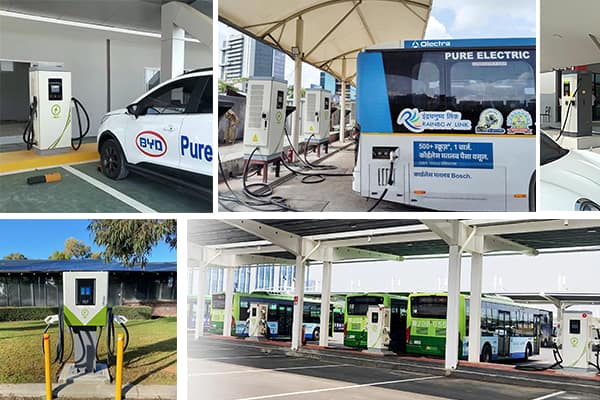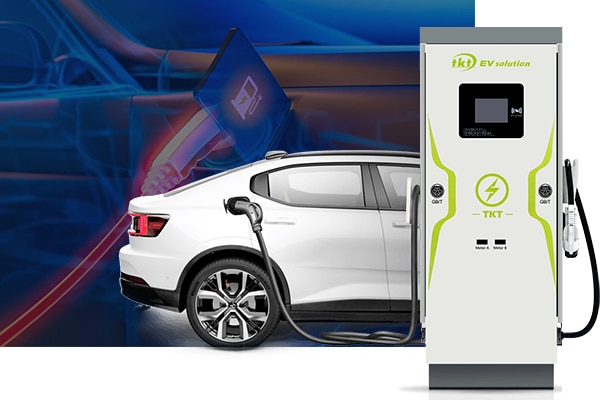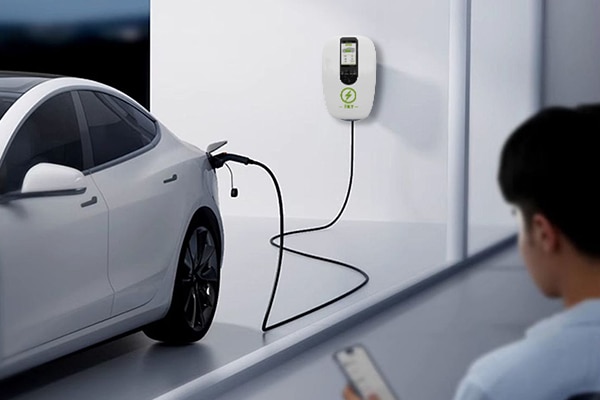電気自動車として (EV) 人気を得る, さまざまな充電オプションを理解することが重要になります. このガイドでは、さまざまなタイプの EV 充電器について詳しく説明します, 彼らの出力, 通常の充電時間, そしてどこでそれらを見つけることができますか. 私たちの目的は、EV の充電について情報に基づいた意思決定を行うのに役立つ詳細な概要を提供することです。.
EV充電器の種類
電気自動車の充電インフラは 3 つの主要なレベルで構成されます: レベル 1, レベル 2, および直流急速充電 (DCFC). 各レベルには明確なメリットがあり、さまざまな状況や環境に適しています。.
レベル 1 充電
レベル 1 充電には標準の家庭用 120 ボルトを使用します (120V) ACコンセント. 最も身近なEV充電方法です, 通常車両に付属する充電器以外に追加の機器は必要ありません. しかし, これは最も遅い充電オプションでもあります.
電力出力: 約 1 kW
BEVの充電時間: 40-50+ までの時間 80% 空から
PHEVの充電時間: 5-6 までの時間 80% 空から
典型的な場所: 家
レベル 1 充電は夜間の家庭での充電に最適です, 車両が長期間電源に接続されたままになる場所.
レベル 2 充電
レベル 2 充電は240Vを利用します (居住の) または208V (コマーシャル) 電気サービス. このタイプの充電器は家庭で一般的です, 職場, そして公共スペース. レベルと比較して充電時間を大幅に短縮します 1.
電力出力: 7 kW – 19 kW
BEVの充電時間: 4-10 までの時間 80% 空から
PHEVの充電時間: 1-2 までの時間 80% 空から
典型的な場所: 家, 職場, 公共
レベル 2 充電器は毎日の使用に最適です, スピードと利便性のバランスを提供する. 車両が数時間駐車される場所に設置されることが多い.
直流急速充電 (DCFC)
DCFC は、充電ステーション内で AC 電力を DC に変換することで急速充電を実現します。, 車両のバッテリーを直接充電します. この方法は、長距離の移動を容易にするために、主要高速道路沿いや交通量の多いエリアで通常見られます。.
電力出力: 50 kW – 350 kW
BEVの充電時間: 20 分まで 1 までの時間 80% 空から
典型的な場所: 公共, 高速道路の廊下
DCFCは長距離旅行中のちょっとした立ち寄りに最適です, ドライバーが車両を急速充電して走行を継続できるようにする.
TKT EVソリューションが生み出す 公共充電ステーション用のDC EV急速充電ステーション. さまざまな電力レベルの注文をサポートします (60/90/120/150/180/200kW).

EVの充電基準と規制
2月に 2023, 連邦道路局 (FHWA), エネルギー統合局の支援 & 交通機関, 連邦政府の資金提供によるEV充電器の新しい国家基準を導入. これらの規格により、信頼性が高く予測可能な充電体験が保証されます, いくつかの重要な側面に対処する:
アクセシビリティ: 充電器は簡単に見つけられる必要があります.
相互運用性: さまざまな車両やネットワークに対応.
信頼性: 高い稼働時間と一貫したパフォーマンス.
将来性のある: 将来を見据えた充電機能に対応する設計.
これらの規制は、EV 充電インフラの標準化において極めて重要です, 広範な導入を促進する, ユーザーの利便性を確保する.
EV充電器の仕様概要
次の表は電力出力をまとめたものです, プラグの種類, およびさまざまな EV 充電器タイプの一般的な充電時間:
| 充電器の種類 | コネクタの種類 | 電圧 | 標準的な電力出力 | PHEVの充電時間 | BEVの充電時間 | 充電時間あたりの電気航続距離 | 典型的な場所 |
| レベル 1 | J1772 | 120 交流電圧 | 1 kW | 5-6 時間 | 40-50 時間 | 2-5 マイル | 家 |
| レベル 2 | J1772 | 208-240 交流電圧 | 7 kW – 19 kW | 1-2 時間 | 4-10 時間 | 10-20 マイル | 家, 職場, 公共 |
| DCFC | CCS, チャデモ, テスラ | 400-1000 直流電圧 | 60 kW – 350 kW | 該当なし | 20 分 – 1 時間 | 180-240 マイル | 公共, 高速道路の廊下 |
コネクタの種類に関する注意事項:
J1772 コネクタ: レベル共通 1 とレベル 2 北米での充電.
CCSコネクタ: 北米、欧州のDCFCに広く使用されています.
CHAdeMOコネクタ: 国産車共通.
テスラコネクタ: テスラの専有物, テスラのスーパーチャージャーを含むすべての充電速度に対応.
充電速度に関する考慮事項:
充電速度はいくつかの要因によって変化する可能性があります, 含む:
充電器のメーカーと状態
周囲温度
車両のバッテリー容量と状態
課金戦略:
充電効率を最適化するには, 特にDCFCの場合, までのみ充電することをお勧めします 80% バッテリー容量の. この時点を超えると、バッテリーの状態を保護するために充電が大幅に遅くなります.
結論:
電気自動車所有のメリットを最大化するには、EV充電の微妙な違いを理解することが不可欠です. 適切な充電レベルを選択し、最新の規格と規制を認識することにより、, ドライバーはシームレスで効率的な充電体験を保証できます. EVの状況が進化し続ける中, 充電技術とベストプラクティスについて常に最新の情報を得ることが、現在および将来の EV 所有者にとって重要です.
TKTのEV充電ステーションは自動充電など多彩な充電方法を提供, 時限充電, 配給充電, SOC充電, 等. 強力な配電と定電力機能により、充電時間を短縮できます。 20%. 強力な配電と定電力機能により、充電時間を短縮できます。 20%. 当社の高品質な製品と効率的なパフォーマンスにより、当社はお客様から広く認められています。.




